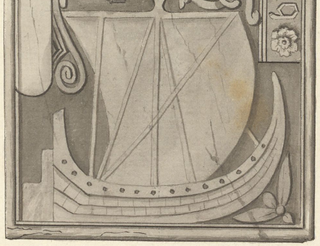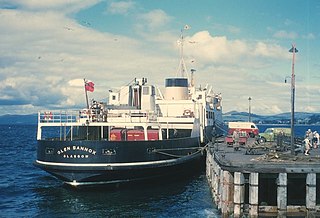
The Highlands is a historical region of Scotland. Culturally, the Highlands and the Lowlands diverged from the Late Middle Ages into the modern period, when Lowland Scots language replaced Scottish Gaelic throughout most of the Lowlands. The term is also used for the area north and west of the Highland Boundary Fault, although the exact boundaries are not clearly defined, particularly to the east. The Great Glen divides the Grampian Mountains to the southeast from the Northwest Highlands. The Scottish Gaelic name of A' Ghàidhealtachd literally means "the place of the Gaels" and traditionally, from a Gaelic-speaking point of view, includes both the Western Isles and the Highlands.

The Firth of Clyde, is the estuary of the River Clyde, on the west coast of Scotland. The Firth has some of the deepest coastal waters of the British Isles. The Firth is sheltered from the Atlantic Ocean by the Kintyre Peninsula. The Firth lies between West Dunbartonshire in the north, Argyll and Bute in the west and Inverclyde, North Ayrshire and South Ayrshire in the east. The Kilbrannan Sound is a large arm of the Firth, separating the Kintyre Peninsula from the Isle of Arran. The Kyles of Bute separates the Isle of Bute from the Cowal Peninsula. The Sound of Bute separates the islands of Bute and Arran.

The Isle of Mull or simply Mull is the second-largest island of the Inner Hebrides and lies off the west coast of Scotland in the council area of Argyll and Bute.

Caledonian MacBrayne, in short form CalMac, is the trade name of CalMac Ferries Ltd, the major operator of passenger and vehicle ferries to the west coast of Scotland, serving ports on the mainland and 22 of the major islands. It is a subsidiary of holding company David MacBrayne, which is owned by the Scottish Government.

The Clyde puffer is a type of small coal-fired and single-masted cargo ship, built mainly on the Forth and Clyde Canal, which provided a vital supply link around the west coast and Hebrides of Scotland.

The birlinn or West Highland galley was a wooden vessel propelled by sail and oar, used extensively in the Hebrides and West Highlands of Scotland from the Middle Ages on. Variants of the name in English and Lowland Scots include "berlin" and "birling". The Gaelic term may derive from the Norse byrðingr, a type of cargo vessel. It has been suggested that a local design lineage might also be traceable to vessels similar to the Broighter-type boat, equipped with oars and a square sail, without the need to assume a specific Viking design influence. It is uncertain, however, whether the Broighter model represents a wooden vessel or a skin-covered boat of the currach type. The majority of scholars emphasise the Viking influence on the birlinn.

MS Caribbean Princess is a modified Grand-class cruise ship owned and operated by Princess Cruises, with a capacity of over 3,600 passengers, the largest carrying capacity in the Princess fleet until June 2013 when the new Royal Princess, another Princess ship superseded its record. She has 900 balcony staterooms and a deck of mini-suites.

The Caledonian MacBrayne fleet is the largest fleet of car and passenger ferries in the United Kingdom, with 36 ferries in operation. A further 5 vessels are currently under construction for the fleet. The company provides lifeline services to 23 islands off the west coast of Scotland, as well as operating routes in the Firth of Clyde.

MV Hebrides is a ferry operated by Caledonian MacBrayne from Uig to Lochmaddy and Tarbert, the main settlements of North Uist and Harris respectively.

MV Isle of Arran is a drive-through ferry operated on the west coast of Scotland by Caledonian MacBrayne. Also known by her local nicknames IOA and The Auld Trooper, she entered service in 1984 on the Ardrossan to Brodick route, serving Arran for nine years before being moved to Kennacraig. She returned to her original route in 2012, supplementing MV Caledonian Isles in summer and becoming a relief vessel for Arran in winter as well as other routes where required. In 2013, she started a new pilot route from Ardrossan to Campbeltown, which became a permanent fixture in 2015. As of 2023, she is one of the oldest vessels in the fleet, having been in service for 40 years; upon arriving into Oban in the West Highlands, celebrations were mounted ashore to mark the 40th anniversary of her launch and service on 2 December 2023.

West Loch Tarbert is a long, narrow sea loch on the western side of the Kintyre Peninsula, in Argyll and Bute, west of Scotland.

The Isle of Arran or simply Arran is an island off the west coast of Scotland. It is the largest island in the Firth of Clyde and the seventh-largest Scottish island, at 432 square kilometres (167 sq mi). Historically part of Buteshire, it is in the unitary council area of North Ayrshire. In the 2011 census it had a resident population of 4,629. Though culturally and physically similar to the Hebrides, it is separated from them by the Kintyre peninsula. Often referred to as "Scotland in Miniature", the Island is divided into highland and lowland areas by the Highland Boundary Fault and has been described as a "geologist's paradise".

Lewis and Harris, or Lewis with Harris, is a Scottish island in the Outer Hebrides, around 24 miles (39 km) from the Scottish mainland.

Inverness-shire or the County of Inverness, is a historic county in Scotland. It is named after Inverness, its largest settlement, which was also the county town. Covering much of the Highlands and some of the Hebrides, it is Scotland's largest county by land area. It is generally rural and sparsely populated, containing only three towns which held burgh status, being Inverness, Fort William and Kingussie. The county is crossed by the Great Glen, which contains Loch Ness and separates the Grampian Mountains to the south-east from the Northwest Highlands. The county also includes Ben Nevis, the highest mountain in both Scotland and the United Kingdom.

MV Hebridean Princess is a cruise ship operated by Hebridean Island Cruises. She started life as the MacBrayne car ferry and Royal Mail Ship, initially RMS then MV Columba, based in Oban for the first 25 years of her life, carrying up to 600 passengers, and 50 cars, between the Scottish islands.

MV Glen Sannox was a Clyde car ferry launched in 1957. Built for the Arran service, she spent her first 14 years there. Thereafter, she had a versatile career on the west coast of Scotland, lasting over 32 years, including providing cruises between 1977 and 1982. In 1989, she was sold for service on the Red Sea. She ran aground south of Jeddah and lay in a sunken condition from 2000.

David MacBrayne is a limited company owned by the Scottish Government. Formed in 1851 as the private shipping company David Hutcheson & Co. with three partners, David Hutcheson, Alexander Hutcheson and David MacBrayne, it passed in 1878 to David MacBrayne.

Caledonian Maritime Assets Limited owns the ferries, ports, harbours and infrastructure for the ferry services serving the west coast of Scotland, the Firth of Clyde and the Northern Isles.

MV Glen Sannox is a car and passenger ferry constructed at Ferguson Marine in Port Glasgow for the Scottish Government asset company CMAL, to lease to its ferry operator Caledonian MacBrayne. Entering service to the Isle of Arran in 2025, she is the first of two dual-fuel CalMac ferries, capable of operating on either marine gas oil, or LNG which offers a marked reduction in sulfur dioxide, nitrous oxide and carbon dioxide emissions. The ship's name recalls an earlier Arran ferry.

The Ferry Fiasco is the political scandal surrounding the construction of the ferries MV Glen Sannox and MV Glen Rosa in Scotland, which has been marred by delays and increasing costs. The ferries are being built by Ferguson Marine, for the state-owned ferry operator Caledonian MacBrayne under direction of Caledonian Maritime Assets (CMA), Transport Scotland, and the Scottish Government. Originally intended to come into service in 2018 and 2019 respectively, both ferries have been delayed by over five years, and costs have more than quadrupled to £450 million.



















